These 7 Popular Houseplants Won’t Survive Without Extra Humidity – Do You Have One? Here’s How to Help Them Thrive
Dry indoor air can be tough on certain tropical plants. Here are 7 high-humidity houseplants you need to protect – and how to help your indoor jungle flourish
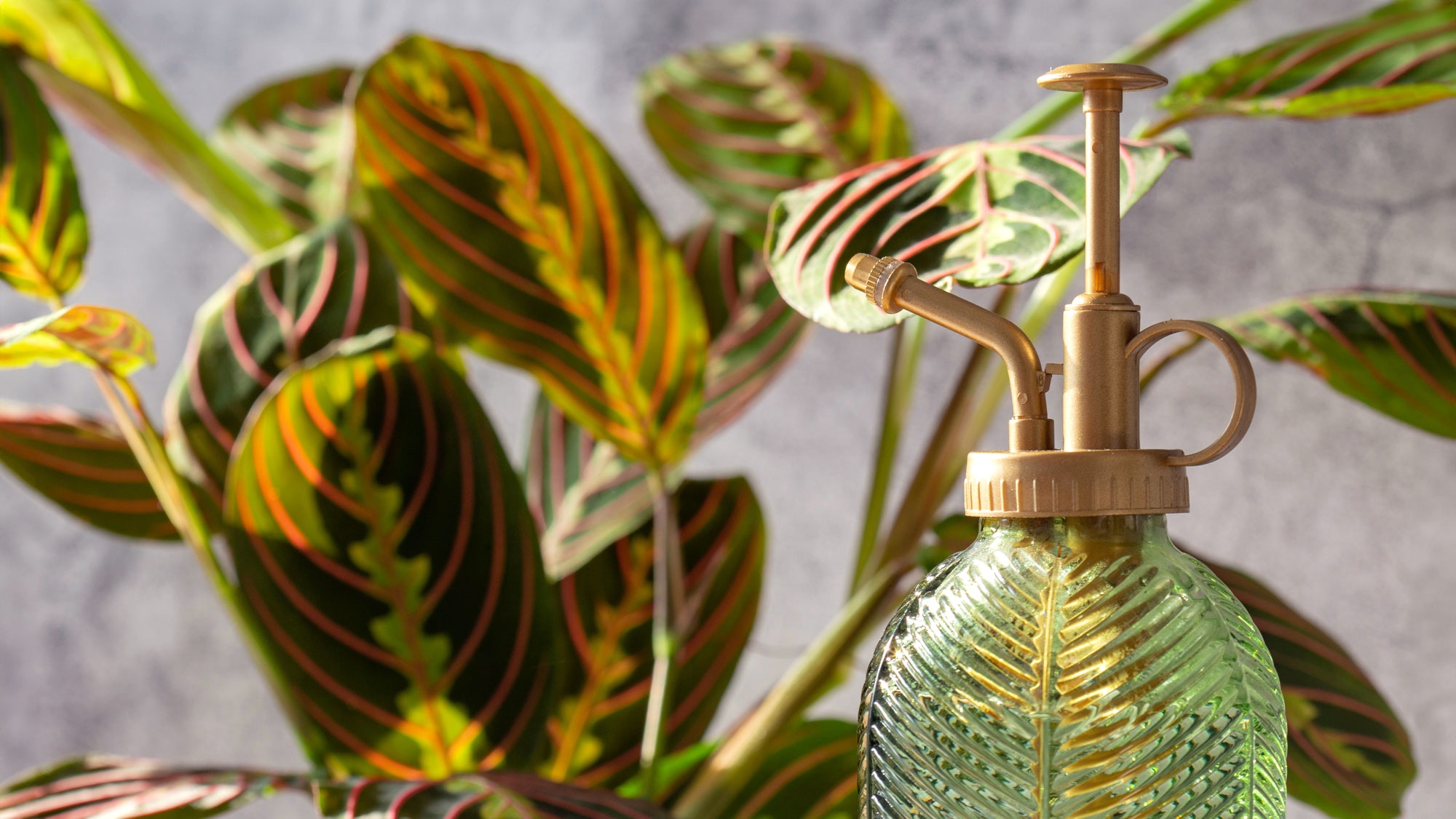

Amy Draiss
There is no single humidity level that is perfect for all plants. However, in general, tropical houseplants need higher humidity levels. This can be a problem in winter, when the air is naturally drier and heating systems suck even more moisture out of the air. We might love our indoors spaces snug and toasty – but our suddenly floppy indoor jungles will struggle.
High humidity plants are usually tropical plants that thrive in warm, moist conditions. If your tropical houseplants are struggling, chances are that low humidity is the hidden culprit. These 7 specific houseplants will grow and thrive best if you can provide higher humidity levels. If you are growing any of these, keep reading to find out how to give yours that boost over the colder months.
Why Humidity is Important for Certain Plants
When we talk of humidity houseplants are often left out to dry. Indoor air can become very dry, particularly over winter as we tend to rely on central heating, which is detrimental to our favorite tropical plants. They need moisture in the air to avoid drying out, to aid transpiration, and to support other natural processes, like photosynthesis.
It’s useful to keep a small hygrometer near indoor plants to identify and monitor humidity levels throughout the day. These devices give real-time readings and help you decide if you need to add humidity to houseplants in winter. An option like the ThermoPro TP50 Digital Thermo-Hygrometer from Amazon is great for cross-referencing humidity data in different spots to identify dry zones.
Most of your favorite high humidity houseplants come from tropical regions that are very wet. Providing more moisture, not just in the soil, but also in the air, helps mimic their natural environments and prevent seasonal stress. The closer you can get to their natural growing conditions, the healthier and happier these plants will be. Cultivating humidity levels that suit individual plant needs should therefore be an essential aspect of caring for houseplants over the cooler months.
Houseplants that Need High Humidity
If you grow any of these popular houseplants, be aware that they need a lot of moisture. They thrive in high humidity environments. Once you can identify plants that like high humidity, you can then take steps to boost their environmental needs.
1. Calathea
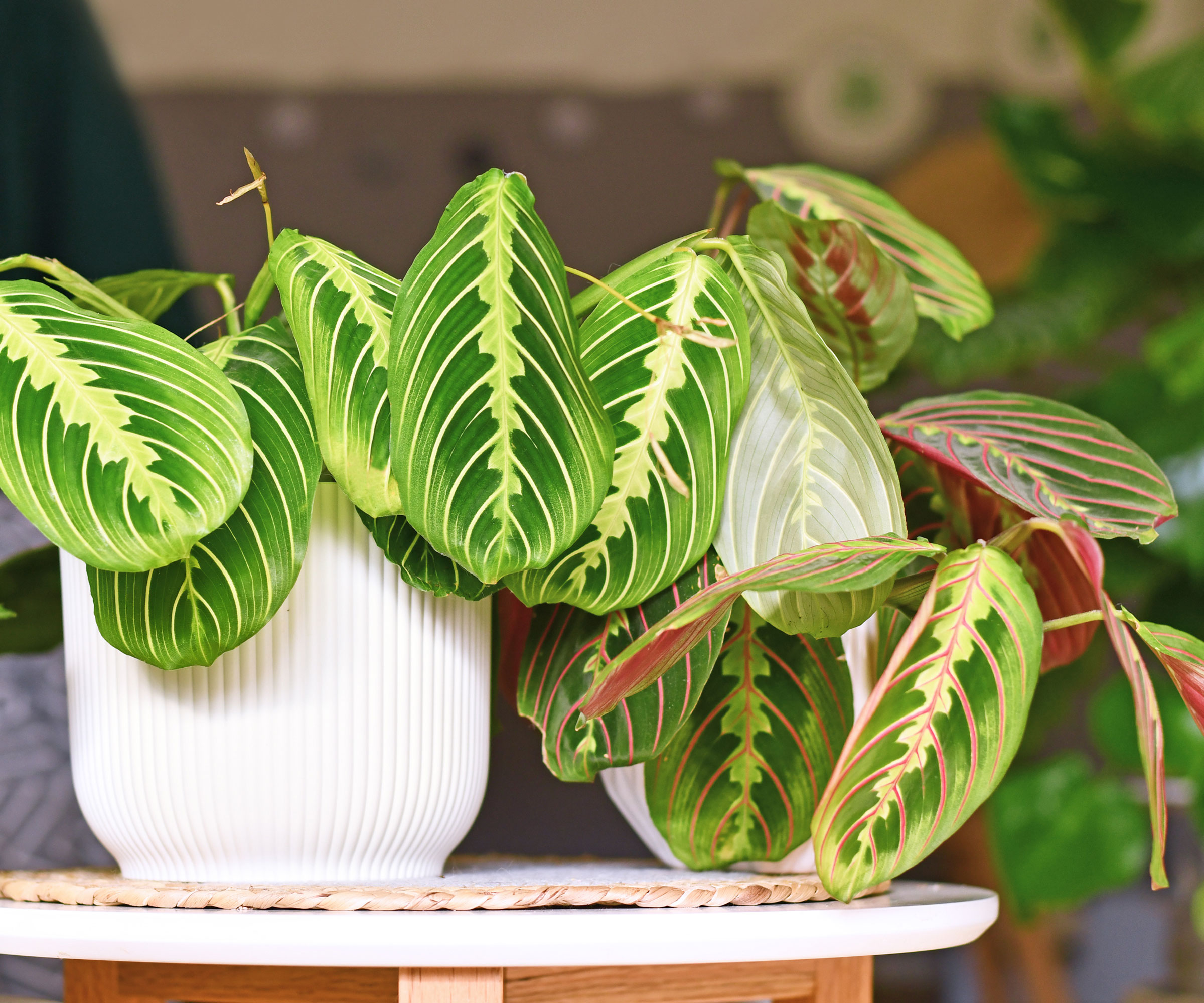
One of the key houseplants for humidity checks is the prayer plant (Calathea), also known as a zebra plant because of its striped leaves. It is native to the Central and South American tropics and doesn’t tolerate temperatures lower than 60 degrees Fahrenheit (16°Celsius). It also needs humidity levels of 50% or higher to grow best.
Sign up for the Gardening Know How newsletter today and receive a free copy of our e-book "How to Grow Delicious Tomatoes".
Calatheas have thin, delicate leaves with a large surface area, which lose moisture quickly in dry air. Their natural understory environment provides constant evaporative humidity from the forest floor. Many species also unfurl new leaves frequently, a process that requires steady ambient moisture. Dry air interferes with leaf movement (nyctinasty), causing the plant to struggle opening and closing its leaves.
Signs of low humidity include crispy brown leaf edges, leaf curling, and leaves that stay partially closed. You should keep the soil lightly and consistently moist using filtered or distilled water, as these plants are mineral-sensitive. Avoid letting the soil dry out fully, but ensure excellent drainage to prevent root rot.
As part of your winter care for calathea, self-watering pots with built-in reservoirs help maintain consistent moisture. These Green Speckled Black Self Watering Plant Pots from Amazon are perfect for helping to maintain consistent moisture reserves.
2. Ferns
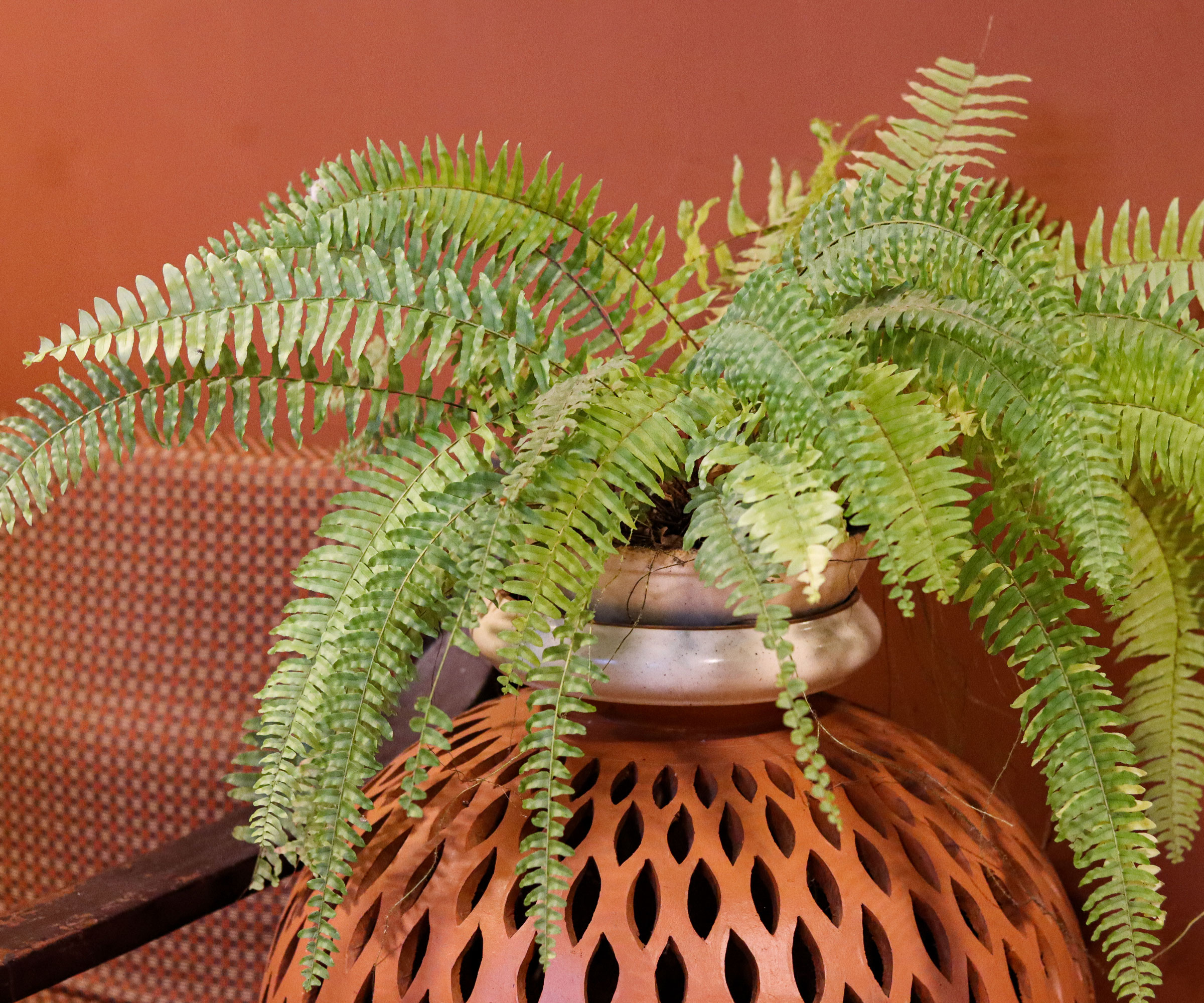
There are many different types of ferns to grow indoors, including native species that grow in cooler climates. However, most houseplant fern varieties, like the Boston fern, staghorn fern and rabbit’s foot fern, are from the tropics. They need a lot of humidity, up to 80% for some varieties, for the happiest plants and lushest displays.
Ferns have extremely fine, feathery fronds with very high transpiration rates, meaning they lose water faster than thick-leaved plants. Many also grow in mossy, humid environments where moisture is constantly available from the air. Staghorn ferns, for example, absorb moisture through shield fronds and need steady humidity to keep those fronds healthy.
Signs of low humidity in overwintering Boston ferns and other indoor fern varieties include crispy fronds, browning tips, frond drop, and stunted new growth. Ferns prefer evenly moist soil (or for staghorns, regular soaking of their mounting medium). Never allow soil to become bone dry, as this is the fastest way to lose a fern.
3. Epiphytic Orchids
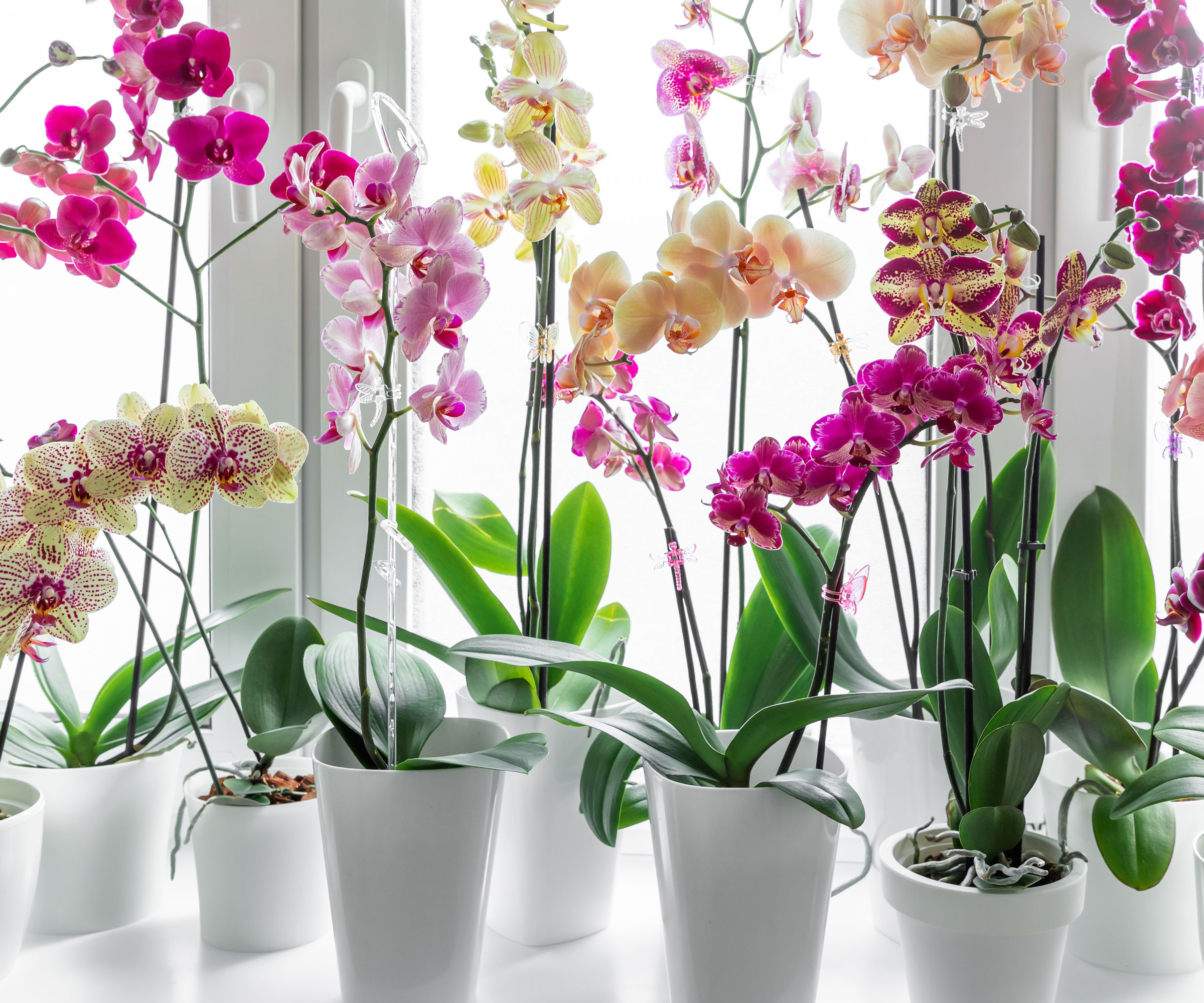
Like ferns, there are many different kinds of orchids from various types of climates, but most indoor orchids are tropical epiphytes. Also known as air plants, epiphytes grow on trees and other plants with their roots in the air rather than in the soil. They depend on high moisture levels in the air to get enough water. Depending on the type, indoor orchids need between 40% and 70% humidity.
Epiphytic orchids like phalaenopsis and dendrobiums absorb moisture primarily through their exposed aerial roots, which are adapted to cling to tree bark in rainforest canopies. These spongy roots (covered in velamen) rely on constant ambient moisture. Their thick leaves hold water, but the roots will dehydrate rapidly in low humidity. Tell-tale signs of low humidity include wrinkled or shriveled roots, limp leaves, bud blast (buds turning yellow and falling off), and rapidly wilting flowers.
Mist aerial roots directly if they seem to dry extremely quickly, but avoid wetting flowers or keeping roots wet for long periods. A fine sprayer can be helpful for lightly hydrating orchid roots. The Lianshi Brass Spray from Amazon is an elegant and inexpensive option for misting orchids around the roots where needed.
4. Peace Lily

Peace lily (Spathiphyllum) is a flowering tropical plant with big, glossy leaves and beautiful white flowers. Peace lilies are generally easy to grow. They can get quite large and last for many years. To help keep your peace lily thriving and growing longer, ensure it has humidity levels around 60%.
Those broad, glossy leaves can transpire readily and their thin cuticles mean they lose moisture faster than many tropical plants. The large leaves and high rate of vegetative growth demand a consistently humid environment. Peace lilies also rely on humidity to support healthy flowering and to prevent drooping. Signs of low humidity include brown leaf tips, drooping (even with moist soil), reduced flowering, and leaves that appear dull rather than glossy.
Peace lilies also appreciate evenly moist soil. Water your peace lilies when the top inch becomes dry, but avoid letting the pot sit in water, which can lead to root rot. Peace lilies also do well in self-watering containers to keep the soil evenly moist when humidity drops.
5. Alocasia
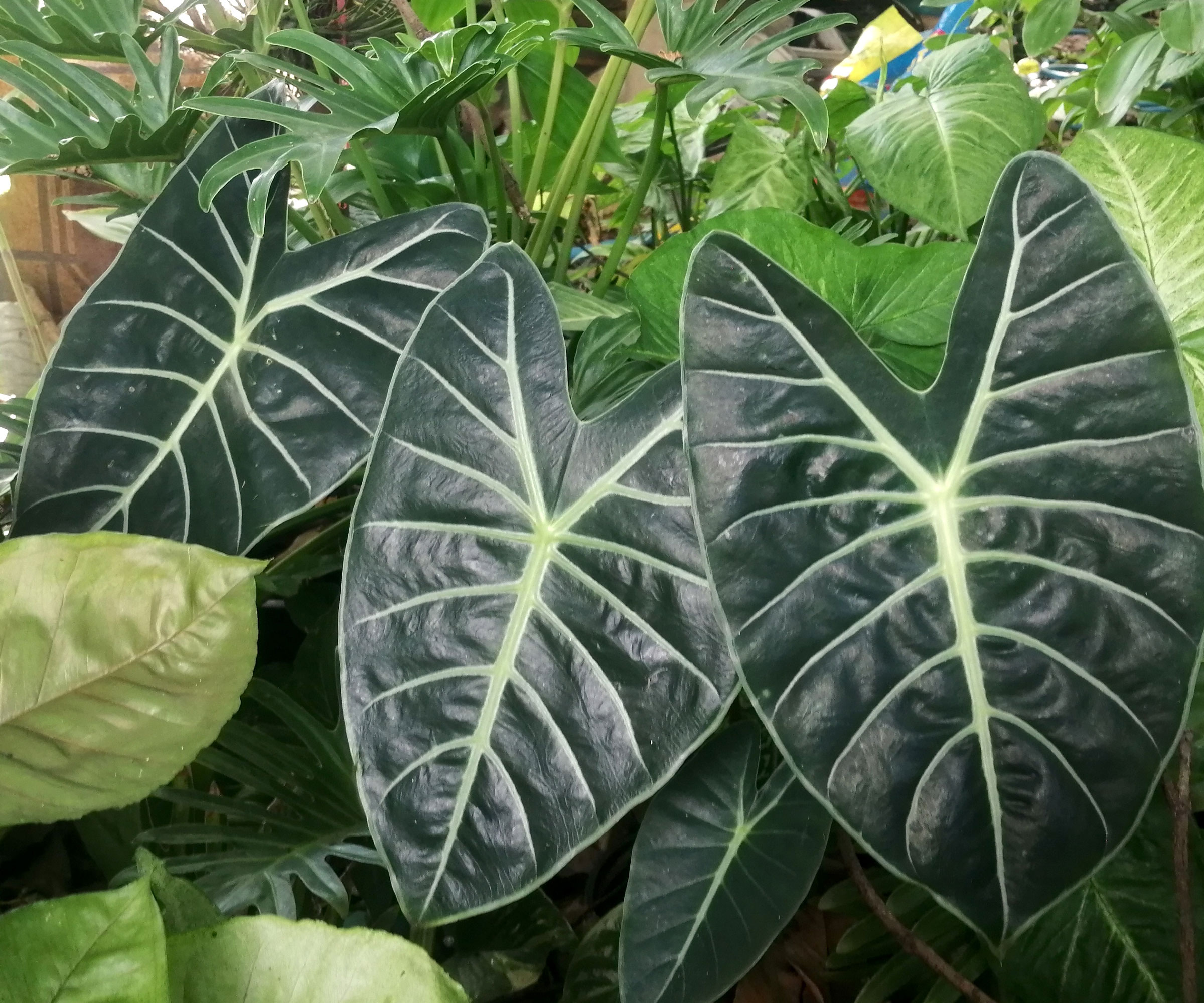
Also known as the elephant ear plant, alocasia has large, attractive leaves. There are several types of elephant ear plant with varied colors and variegated patterns. Alocasia is native to the tropics of Southeast Asia and Oceania, and needs warm temperatures and humidity levels around 60% or higher in order to thrive.
Their large, thin leaves work almost like moisture radiators. Because of the relatively large leaf surface area, they lose water rapidly, requiring high humidity to prevent constant transpiration stress. They also grow from corms that store energy but not a lot of water, so lack of humidity directly impacts the ability to produce new leaves.
Low-humidity signs include crispy or curling leaf edges, drooping leaves, increased spider mite activity, and leaf drop. When growing elephant ear plants indoors, keep soil moderately moist but never soggy. Alocasias love moisture but are prone to rot, so use chunky, quick-draining soil, and avoid letting the pot dry out completely.
Elephant ear plants are especially happy in bathrooms during the cooler months. If you plan to move yours into a bathroom for winter, use a moisture-safe plant stand to keep them away from splashes while still ensuring plenty of humidity. A plant stand like the best-selling Bamworld Wooden Plant Stand from Amazon can protect and support alocasia foliage during winter, while you keep your plants more humid.
6. Anthurium

Anthurium species, native to the American tropics and subtropics, are distinctive and generally easygoing as houseplants. Anthuriums have thick, glossy leaves, but these colorful houseplants still rely heavily on humidity. Most varieties are epiphytic or semi-epiphytic. Their roots prefer moist air pockets rather than compact, dry soil. High humidity supports glossy foliage, colorful spathes, and steady new growth. In dry environments, their leaves struggle to maintain shine and turgor.
Low-humidity signs include brown leaf edges, yellowing tips, dull foliage, and slow or misshapen new leaves. Flowers may be smaller or fail to develop fully. Make sure your indoor anthurium plants are kept in a place with 60% to 80% humidity. However, although these plants like moisture, they are susceptible to overwatering as well as overly compact soil. Use a loose potting mix with orchid bark and perlite, plus a container with good drainage to avoid waterlogging.
7. Philodendron & Monstera
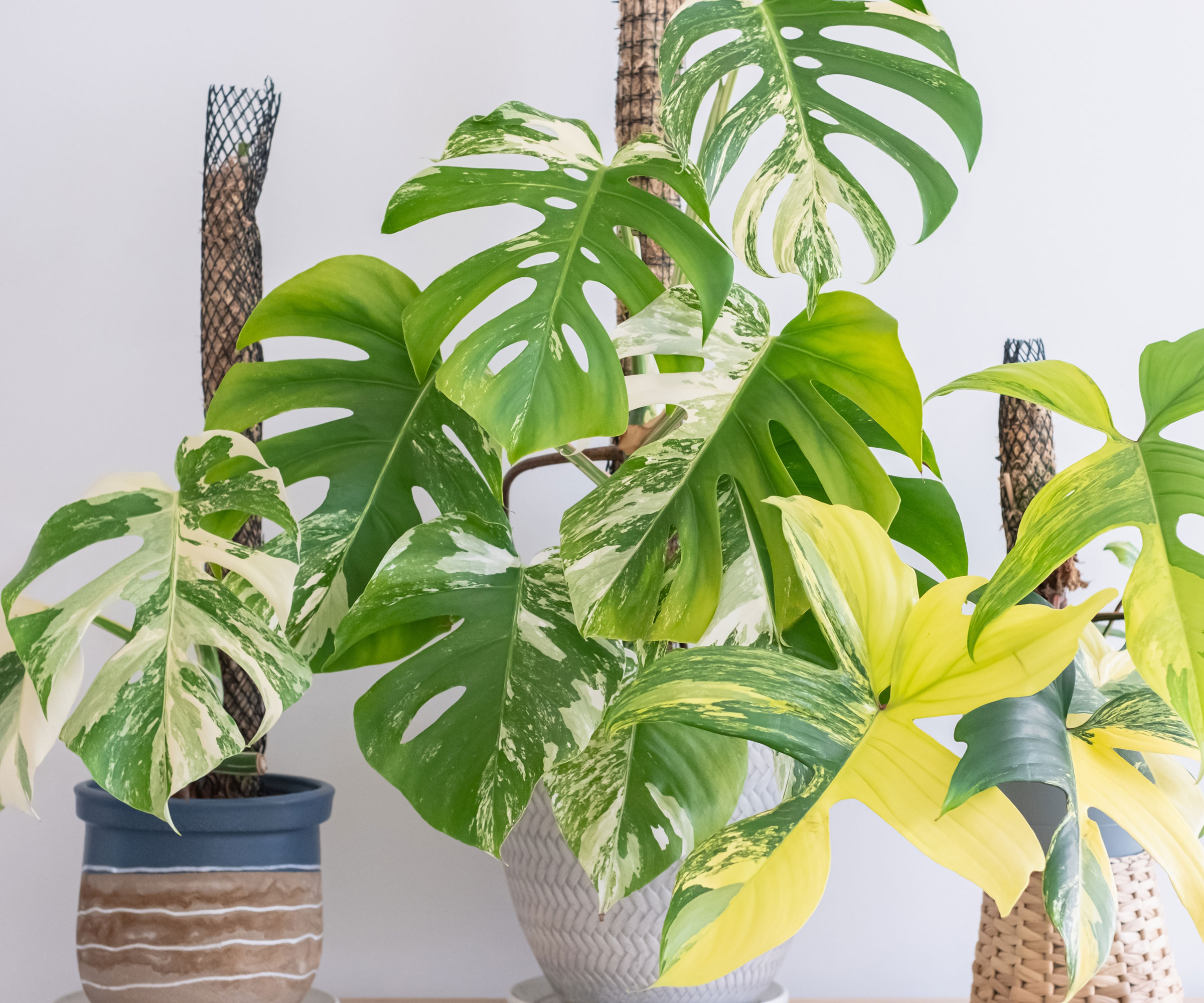
These popular houseplants belong to the same family and have similar needs. Both are native to Central America. Monstera plants are sometimes called Swiss cheese philodendrons because of the holes in their leaves. In addition to warm temperatures, these plants thrive in 60% humidity.
Philodendrons and monstera plants have thin but waxy leaves and typically grow as climbing or trailing epiphytes or hemiepiphytes in the tropics. Their aerial roots absorb moisture from humid air, helping support large leaves and steady growth. High humidity also reduces leaf tearing and helps new leaves unfurl properly, especially in monstera fenestrations.
Tell-tale signs of low humidity include brown, crispy leaf edges, leaves getting stuck while unfolding, smaller mature leaves, and increased tearing. Allow the top few inches of soil to dry out between watering. Key philodendron varieties and monstera plants like moisture but dislike soggy soil. A moss pole filled with sphagnum moss or coir can also help trap moisture and boost humidity around aerial roots. The EOK Sphagnum Moss Pole Kits from Amazon support four monstera plants, but you can choose from a range of other pole sizes and quantities.
How to Increase Humidity for These Plants
The above are excellent houseplants to grow if you have high humidity, but most of us struggle with dry indoor air, especially in winter. Many homes dip down to 30% humidity or even lower during colder months. Here are some quick ways to tip the odds in your favor and give your tropical houseplants the conditions they crave:
- One easy way to raise humidity for houseplants is to set them on pebble trays. These are relatively inexpensive and can look attractive. Many come in decorative styles like this elegant Ceramic Humidity Tray from Walmart. Fill a shallow tray with pebbles and water, then place the pots on top of the stones. Fantian Pebbles from Amazon come in a choice of mixed colors and weight distributions. The evaporating moisture boosts humidity around the leaves. You can also increase moisture in the air by grouping potted plants together. Just be sure there is enough air flow between plants and leaves to prevent fungal issues.
- A room humidifier is one of the most effective devices for raising humidity in the home. Many compact cool-mist models can be run near your tropical plants continuously during winter. Choose a unit with adjustable output or a built-in humidity gauge if you need more control. The 4L Ultrasonic Cool Mist Humidifier from Amazon has a large tank for a moisture-rich environment. Placing plants in the same room as your humidifier helps them receive consistent moisture.
- Smaller plants can also be grown in terrariums, mini greenhouses or humidity domes, which help trap moisture around delicate foliage. These can create the ideal microclimates for ferns, calatheas, and other humidity-loving plants. The Yimorence Terrarium from Amazon is an elegant, old-fashioned Victorian-style humidity booster for smaller ferns and epiphytic orchids.
- For climbing tropicals like monstera or philodendron, moss poles filled with sphagnum can hold moisture around aerial roots, creating a mini microclimate right at the plant’s center. If you prefer, you can get coco coir poles that work just as well, such as the Oulastool Plant Support Poles from Walmart.
- Bathrooms are especially good locations for tropical plants because they naturally stay more humid. If you have space and enough light, consider moving tropical plants into a bathroom during the driest months.
Ensure proper watering is a continued priority for tropical houseplants during winter. Check they have good drainage but also consistently moist soil to prevent the stress of getting too dry. Try these Ceramic Worm Water Sensors from Amazon to assess water levels, and adapt accordingly. Houseplants bring great joy and cheer to your indoor spaces during winter. Just follow these steps and show them some love by doing what you can to increase humidity and keep them healthy and thriving.
Need more ideas for timely gardening jobs and seasonal expert advice delivered straight to your inbox? Sign up for the free Gardening Know How Newsletter!

Mary Ellen Ellis has been gardening for over 20 years. With degrees in Chemistry and Biology, Mary Ellen's specialties are flowers, native plants, and herbs.
- Amy DraissDigital Community Manager